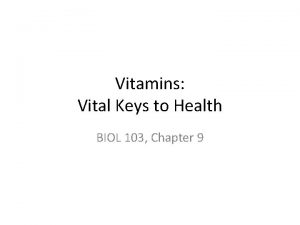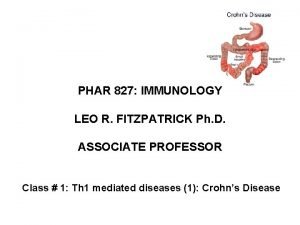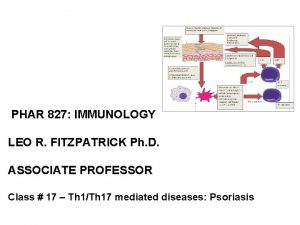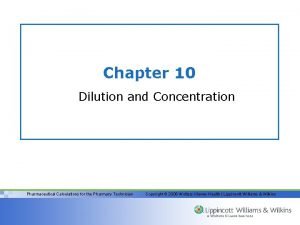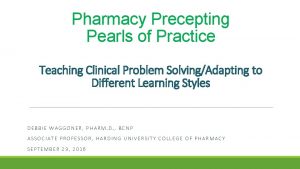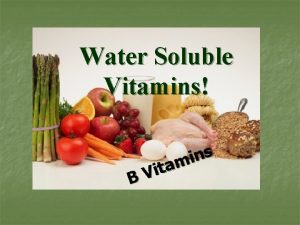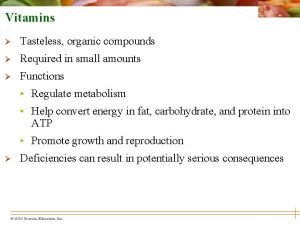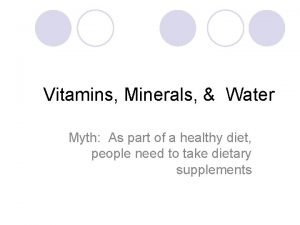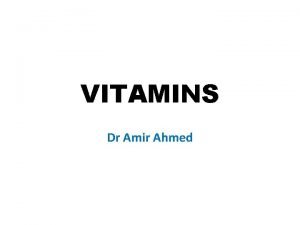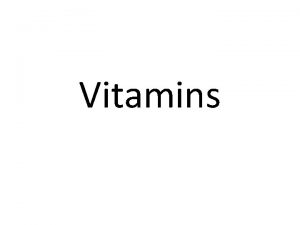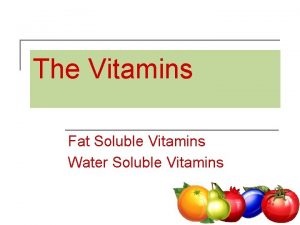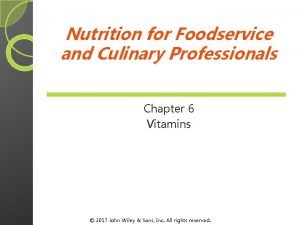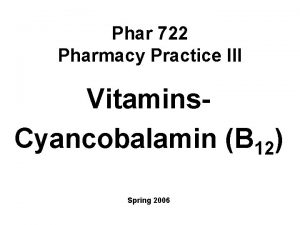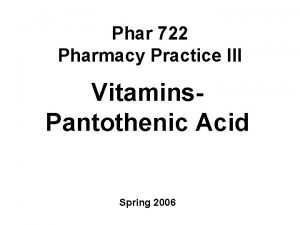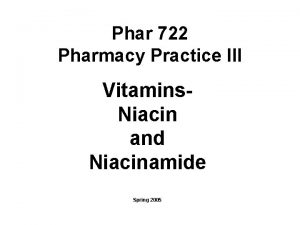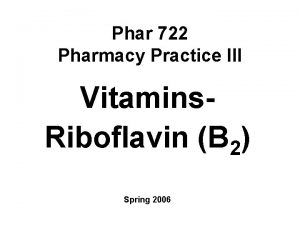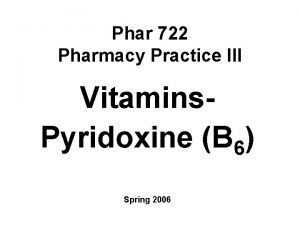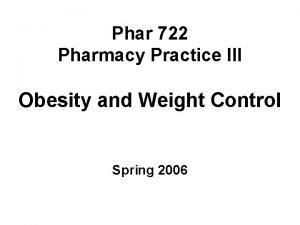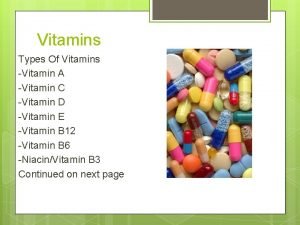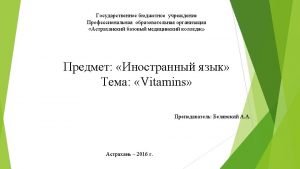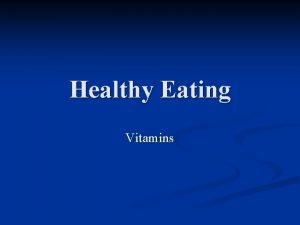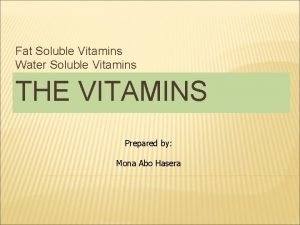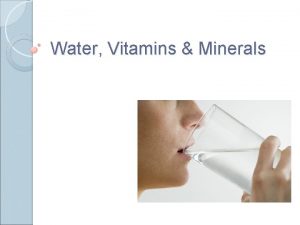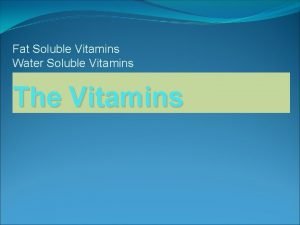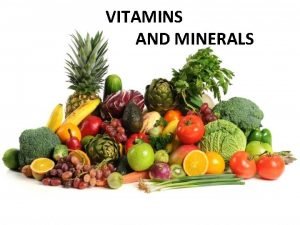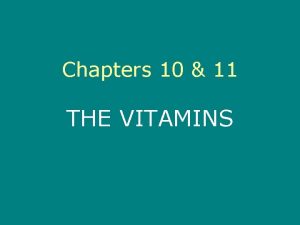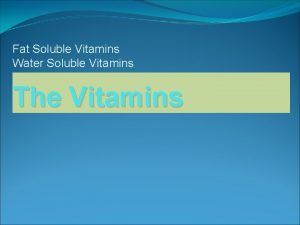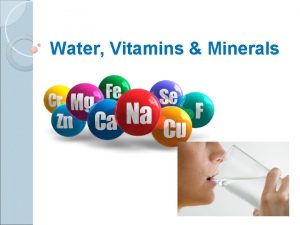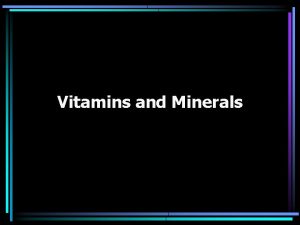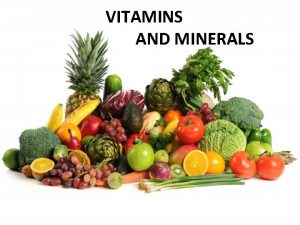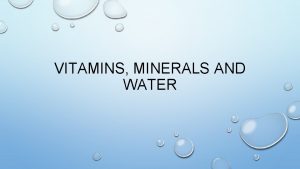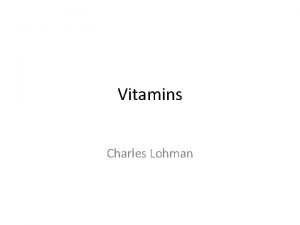Phar 722 Pharmacy Practice III Vitamins Vitamin E


























- Slides: 26

Phar 722 Pharmacy Practice III Vitamins. Vitamin E Family Spring 2006

Vitamin E Study Guide • The applicable study guide items in the Vitamin Introduction • History • Structure of the active and commercial forms • Transport of the vitamin • Compare and contrast vitamin deficiencies in humans relative to animals • Role of structurely related compounds • Hypervitaminosis E • Approaches to formulation

Vitamin E History • 1922 – Evans and Bishop showed that rats maintained on certain diets did not produce offspring. – These same rats seemed normal in all other respects including physical growth. – The condition could be corrected by addition of lettuce, whole wheat, and cereal grains. – Later it was shown that the vitamin activity was in certain wheat germ oils.

Vitamin E Chemistry-1 • The tocopherols and tocotrienols are natural antioxidants found in vegetable oils. – Historically, they were removed during the refining process. – Of course this means that the refined products are subject to oxidative spoilage. Therefore, the manufacturers add antioxidants back into the products. • These may be tocopherols or synthetic compounds. – Tocopherols are widely used as antioxidants in prepared foods. • The milling companies are major suppliers of tocopherols extracted from the wheat germ.

Vitamin E Chemistry-2 • Tocopherol means child bearing alcohol. – tokas - child – phero - to bear – ol – alcohol • The chemistry is complex. – There a family of tocopherols, with αtocopherol showing the most specific vitamin activity based on a rat fertility assay. – Consensus is developing that vitamin E should be defined as 4 tocopherols and 4 tocotrienols.

Vitamin E Chemistry-3 • The stereochemistry is very important! • There are three chiral centers (position 2 on the chroman ring and positions 4' and 8' on the phytyl chain. This means that eight isomers are possible. – The normal situation seen with vitamins that have two or more stereoisomers is only one isomer is active. Thus a racemic (usually represented as d, l) mixture contains 50% of the activity compared with an equi-molar amount of the active isomer.



Vitamin E Uptake • Bile (conjugated bile salts) is essential for absorption. • The vitamin usually is present in food or vitamin supplements as an ester. This is hydrolyzed in the intestinal tract. The free tocopherol becomes part of the mixed micelles. Absorption is 35 -85% efficient. • Entry into the body is made on the chylomicrons by the lymphatic system. The vitamin is transported throughout the body on chylomicrons, VLDL, and HDL. It is distributed in adipose tissue, liver and muscle. – There is evidence that transport across the intestinal mucosa cells followed by incorporation into chylomicrons may favor RRR αtocopherol because of an α-tocopherol transfer protein. • The natural RRR isomer is preferred for incorporation into very low density lipoprotein (VLDL). • The tocopherols can be considered nature’s oil soluble antioxidant in both plants and animals with animals, including humans, obtaining the vitamin from plants.

Vitamin E Deficiencies-1 • There has been a considerable mystique that surrounds this vitamin. • There doesn't seem to be a defined deficiency syndrome in humans for which there is a parallel model in animals. – To put it another way, there is no valid animal model that can be extrapolated into humans. • The next slide shows one classification system for tocopherol deficiencies.

Vitamin E Deficiencies in Animals and Humans • Vitamin E Deficiencies Seen in Animals – Reversible reproductive failure in the female rat. – Irreversible degeneration of rat testicular tissue. – Nutritional muscular dystrophy in monkeys, rabbits, guinea pigs, lambs, calves, turkeys and chicks. – Anemia in monkeys. • Vitamin E deficiency seen in humans (Most reported deficiencies are caused by problems with fat absorption. ) – A partially reversible set of neurological problems. – Hemolytic anemia in premature infants.

Vitamin E Deficiencies-2 • In summary, there seems to be a general antioxidant role and a specific function in the cell's oxidation-reduction systems. This may complement some of the functions attributed to glutathione. • There has been considerable debate as to whether the RRR isomer is the only biologically active form of the vitamin. The synthetic form of the vitamin is a mixture of all eight stereo isomers (now referred to as rac-α-tocopherol rather than d, l-α-tocopherol). – Many of the research articles reporting on the effectiveness of vitamin E use commercial products which usually have a mixture of isomers and don’t have any tocotrienols. • Recently, there is debate as to whether the α and γ forms have different in vivo activities. – γ-Tocopherol is the predominant dietary form. – But α-tocopherol may displace the γ-isomer. • Because there are both general and stereo-specific antioxidant activities, the RDA tables state that the activity ratio of RRR-αtocopherol to rac-α-tocopherol is 1 to 1. 36.

Vitamin E Deficiencies-3 • Complicating these evaluations further is the observation that an in vitro comparison of the antioxidant activities of α-, β-, γ-, and δ-tocopherols is not parallel with in vivo vitamin results in rats.

Vitamin E Deficiencies-4 • • The in vivo rat fetal rankings for the tocopherols are: α>β>γ>δ Depending on the solvent, the in vitro antioxidant rankings can parallel the in vivo. When carrying out the evaluation in fats and oils, the in vitro rankings are: δ>γ≈β>α • All isomers are antioxidants and probably do provide general antioxidant protection internally or in vivo. On the other hand, evidence points to the RRR isomer as being specific for a variety of reductase systems, possibly involving selenium (Se) and glutathione (GSH/GSSG). The "Relative Biological Activity" in the previous table is based on a rat resorption-gestation assay. • The next two slides illustrate how the tocopherol family might function as antioxidants.

Possible Vitamin E Antioxidant Mechanism

Possible Free Radical Antioxidant Mechanism

Vitamin E Deficiencies-5 • Consistent with antioxidant model, the RDA is based on the polyunsaturated fatty acid (PUFA) consumption. The implication is that, if a increased PUFA intake is recommended, the RDA for tocopherol should be increased. • The hemolytic anemia seen in premature infants is one of the few specific nutritional deficiencies seen in humans. – Because of poor placental transfer, newborn have little of the vitamin. Human milk contains 2 - 5 mg/liter. Cow's milk contains less.

Current Information on Vitamin E • γ-Tocopherol is the most common form in the U. S. diet, but αtocopherol is the most common form found in the blood. – In the blood on: lipoproteins (VLDL, etc. ) – α-Tocopherol may be more effective than γ-tocopherol in protecting against prostate cancer. This may be more effective in smokers. – See food lists for distribution of the α and γ forms. • Some evidence that vitamins C and E, zinc and , but not βcarotene, help patients with early signs of age-related macular degeneration. – Current trial involving these nutrients plus selenium underway. • Meta-analysis show no risk reduction for myocardial infarction, stoke or cardiovascular death. • Some studies show increased oxidant activity with doses above 400 IU. • Vitamin E did not slow the progression of Alzheimer’s Disease.

Hypervitaminosis E • This is a relatively safe vitamin. • But toxicities have been reported involving chronic administration of 300 – 1200 mg per day. – The symptoms can be very serious and include thrombophlebitis, pulmonary embolism, hypertension, breast development in men and children, severe fatigue, and nonmalignant breast tumors. • In 2004, there were news reports that high doses (2000 IU/day) of vitamin E slowed the progression of Alzheimer’s Disease. What the news failed to report was that a diet rich in foods containing vitamin E may help protect some people against Alzheimer’s Disease. – There at least five ongoing studies examining the role of antioxidants in delaying onset of Alzheimer’s Disease.

Dosage Forms • Stability – The tocopherols, being antioxidants, are very sensitive to oxygen. Sensitive to UV light is another problem. There are two provitamin esters that are used commercially. • Acetate – used in oils, emulsions, gelatin matrices, etc • Hemisuccinate – Used in dry dosage forms requiring a free flowing powder. In theory, the sodium salt would be water soluble enough for aqueous injections.

Vitamin E Dosage Forms

DRIs (based on α-tocopherol)-1 • AI – Infants (0 - 12 months) 0. 6 mg/kg/day • EAR – – – – – Children (1 - 8 years) Boys (9 - 18 years) Girls (9 - 18 years) Men (19 - 50 years) Women (19 - 50 years) Men (51 - 70+ years) Women (51 - 70+ years) Pregnancy Lactation 5 - 6 mg/day 9 - 12 mg/day 12 mg/day 16 mg/day

DRIs (based on α-tocopherol)-2 • RDA – Children (1 - 8 years) – Boys (9 - 18 years) – Girls (9 - 19 years) – Men (19 - 50 years) – Women (19 - 50 years) – Men (51 - 70+ years) – Women (51 - 70+ years) – Pregnancy – Lactation 6 - 7 mg/day 11 - 15 mg/day 15 mg/day 19 mg/day

DRIs (based on α-tocopherol)-3 • UL – Infants Not established (Do not give supplements; use only food and formula for sources. ) – Children 200 mg/day (1 - 3 years) up to 600 mg/day (9 - 13 years) – Adolescents 800 mg/day – Adults (19+ years) 1, 000 mg/day – Pregnancy 800 - 1, 000 mg/day – Lactation 800 - 1, 000 mg/day

Food Sources-1 • α-Tocopherol – Almonds, hazelnuts, sunflower seeds – Spinach – Olive oil, canola oil • γ-Tocopherol – Soybean oil, corn oil • Tocotrienols – bran and germ fractions of certain seeds and cereals

Food Sources-2
 Water soluble vitamins vs fat soluble vitamins
Water soluble vitamins vs fat soluble vitamins A kingdom divided
A kingdom divided Ist 722 github
Ist 722 github Ssis-722
Ssis-722 Grammer 722
Grammer 722 Grammer 722
Grammer 722 Li ping phar
Li ping phar Li ping phar
Li ping phar Leo phar
Leo phar Leo phar
Leo phar History of ray tracing
History of ray tracing Hamlet act iii scene iii
Hamlet act iii scene iii Consultation skills for pharmacy practice
Consultation skills for pharmacy practice Dilution pharmacy calculations
Dilution pharmacy calculations Peter bai
Peter bai Consultation skills for pharmacy practice
Consultation skills for pharmacy practice Pharmacy practice pearls
Pharmacy practice pearls Gpp good pharmacy practice
Gpp good pharmacy practice Water soluble vitamins characteristics
Water soluble vitamins characteristics How are water-soluble vitamins absorbed
How are water-soluble vitamins absorbed Minerals and their functions sources and deficiency chart
Minerals and their functions sources and deficiency chart Keratomalacia
Keratomalacia Vitamin classification chart
Vitamin classification chart Vitamins and their deficiency
Vitamins and their deficiency Vitamins and their other names
Vitamins and their other names The chef does everything but cook that's what wives are for
The chef does everything but cook that's what wives are for Categories of vitamins
Categories of vitamins
